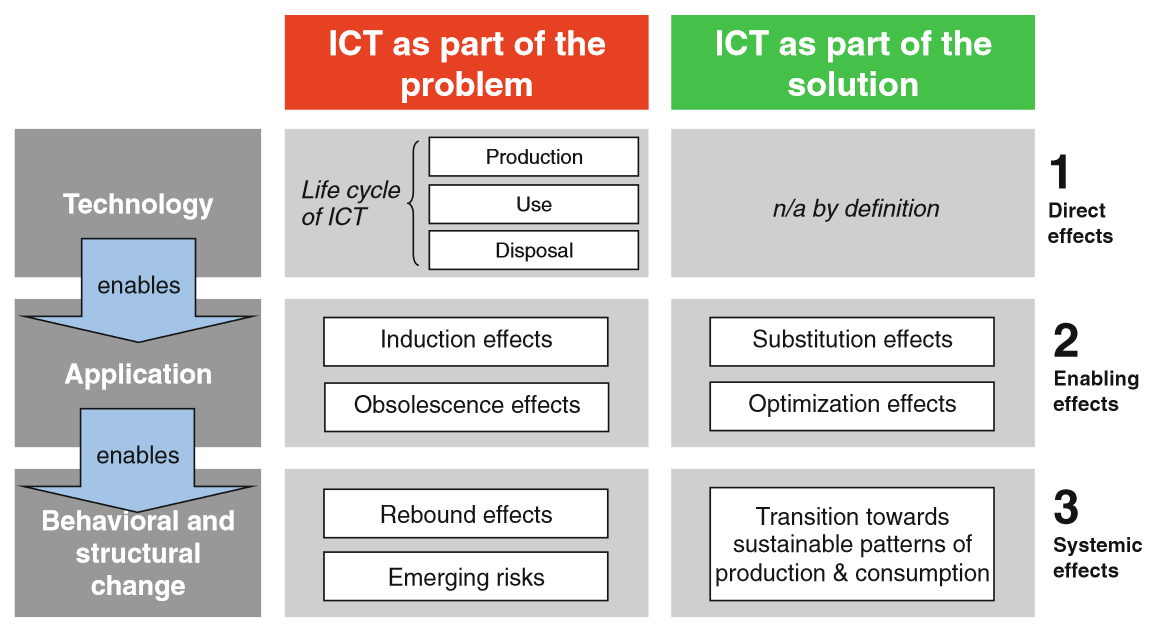ICT for Sustainability: An Emerging Research Field
Status:: 🟨
Links:: Digital Rebound Effect
Metadata
Authors:: Hilty, Lorenz M.; Aebischer, Bernard
Authors:: Hilty, Lorenz M.; Aebischer, Bernard
Title:: ICT for Sustainability: An Emerging Research Field
Date:: 2015
Publisher:: Springer International Publishing
URL::
DOI:: 10.1007/978-3-319-09228-7_1
Hilty, L. M., & Aebischer, B. (2015). ICT for Sustainability: An Emerging Research Field. In L. M. Hilty & B. Aebischer (Eds.), ICT Innovations for Sustainability (pp. 3–36). Springer International Publishing. https://doi.org/10.1007/978-3-319-09228-7_1
This introductory chapter provides definitions of sustainability, sustainable development, decoupling, and related terms; gives an overview of existing interdisciplinary research fields related to ICT for Sustainability, including Environmental Informatics, Computational Sustainability, Sustainable HCI, and Green ICT; introduces a conceptual framework to structure the effects of ICT on sustainability; and provides an overview of this book.
Notes & Annotations
Color-coded highlighting system used for annotations
📑 Annotations (imported on 2024-01-23#21:36:27)
In engineering contexts, there is a tendency to focus on energy use or CO2 emissions as central resource-oriented indicators. The terms ‘‘energy-efficient,’’ ‘‘carbon-neutral,’’ and ‘‘sustainable’’ are often used interchangeably. However, this is an oversimplification, for three reasons. First, the diffusion of energyefficient technologies does not necessarily lead to an overall reduction of energy use: efficient technologies can also stimulate the demand for the resource they use efficiently. This is known as Jeavons’ paradox or the ‘‘rebound effect.’’ Second, the production, use, and disposal of these technologies needs resources as well: When assessed from a life-cycle perspective, energy efficiency may look somewhat different. Third, although energy is crucial, the impact on other natural resources should also be included.
ICT4S can be subdivided into:
- Sustainability in ICT: Making ICT goods and services more sustainable over their whole life cycle, mainly by reducing the energy and material flows they invoke
- Sustainability by ICT: Creating, enabling, and encouraging sustainable patterns of production and consumption by means of ICT
Many authors differentiate between the first-, second- and third-order effects of ICT, a classification originally introduced by Berkhout and Hertin in a 2001 OECD report [64]:
- ‘‘Direct environmental effects of the production and use of ICTs’’
- Indirect environmental impacts through the change of ‘‘production processes, products, and distribution systems’’
- Indirect environmental impacts ‘‘through impacts on life styles and value systems’’ [64, p. 2]
- Berkhout, F., Hertin, J.: Impacts of information and communication technologies on environmental sustainability: speculations and evidence. Report to the OECD. http://www. oecd.org/dataoecd/4/6/1897156.pdf (2001). Accessed 2 June 2014
Level 1 refers to the direct effects of the production, use and disposal of ICT, effects that can be assessed with a Life-Cycle Assessment (LCA) approach. In particular, this includes the demand for materials and energy throughout the whole life cycle. These effects are placed entirely on the negative side as they represent the cost of providing ICT services.
Level 2 refers to the enabling effects of ICT services, or the effects of applying ICT. Two of them are attributed to the ‘‘problem’’ side, two to the ‘‘solution’’ side:
- Induction effect: ICT stimulates the consumption of another resource (e.g., a printer stimulates the consumption of paper as it uses it faster than a typewriter).
- Obsolescence effect: ICT can shorten the useful life of another resource due to incompatibility (e.g., a device that is no longer supported by software updates is rendered obsolete).
- Substitution effect: The use of ICT replaces the use of another resource (e.g., an e-book reader can replace printed books, which is positive if it avoids the printing of a sufficiently large number of books).
- Optimization effect: The use of ICT reduces the use of another resource (e.g., less energy is used for heating in a smart home that knows where the people who live in it are located, which windows are open, what weather is forecast, etc.).
Level 3 refers to the systemic effects, i.e. the long-term reaction of the dynamic socio-economic system to the availability of ICT services, including behavioral change (life styles) and economic structural change. On the negative side, rebound effects prevent the reduction of total material resource use despite decoupling by converting efficiency improvements into additional consumption, and new risks may emerge, for example due to the vulnerability of ICT networks. On the positive side, ICT has the potential to support sustainable patterns of production and consumption.
